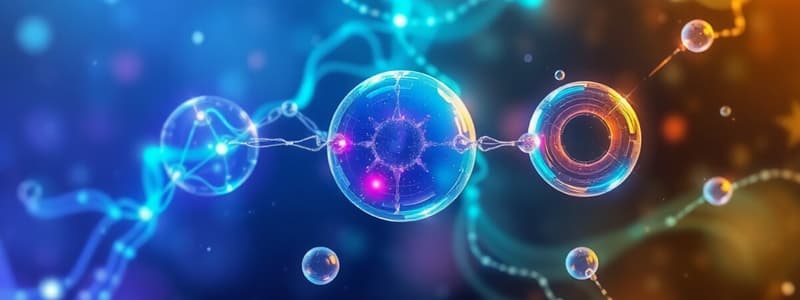Podcast
Questions and Answers
What is the primary role of trace elements in living organisms?
What is the primary role of trace elements in living organisms?
- They form the majority of the mass.
- They act as catalysts. (correct)
- They provide structural support.
- They are the most abundant elements.
What type of bond is formed when one atom transfers valence electrons to another atom?
What type of bond is formed when one atom transfers valence electrons to another atom?
- Covalent bond
- Metallic bond
- Ionic bond (correct)
- Hydrogen bond
Which of the following statements about electron sharing is correct?
Which of the following statements about electron sharing is correct?
- It always involves a complete transfer of electrons.
- It never leads to stable configurations.
- Only bilateral sharing is stable.
- It can be unilateral or bilateral. (correct)
How many natural elements are approximately known?
How many natural elements are approximately known?
Which of the following elements is NOT one of the four common elements that make up 99% of living organisms?
Which of the following elements is NOT one of the four common elements that make up 99% of living organisms?
Study Notes
Introduction
- Matter constitutes the universe, possessing volume and mass.
- Elements, the building blocks of matter, consist of a single type of atom.
- Approximately 92 elements naturally occur.
- Four elements, Carbon, Oxygen, Hydrogen, and Nitrogen, collectively comprise 99% of living organisms.
- Trace elements like Iron, Zinc, Copper, Molybdenum, and Fluorine play catalytic roles despite their minute presence.
- Molecules are formed by the bonding of two or more atoms.
- Intermolecular bonds contribute to the formation of the majority of matter within living organisms.
Classification of Chemical Bonds
- Chemical bonds are categorized into strong and weak bonds.
Strong Bonds
Ionic bonds
- Formed by the transfer of valence electrons from one atom to another.
- This transfer results in the formation of oppositely charged ions, leading to attraction.
- Sodium chloride (NaCl) serves as an example.
Bond formation through electron transfer
- An electron's movement from one atom to another initiates bond formation.
- This process generates ions with opposing charges.
- The attraction between these oppositely charged ions establishes an ionic bond.
- Sodium chloride (NaCl) exemplifies this phenomenon.
Bonds formed by electron sharing
- Complete electron transfer is not always necessary for atoms to achieve stability.
- Atoms can share electrons to fill their valence shells.
- This sharing can be bilateral or unilateral.
Studying That Suits You
Use AI to generate personalized quizzes and flashcards to suit your learning preferences.
Description
This quiz explores the fundamental concepts of matter, elements, and chemical bonds. You'll learn about the classification of chemical bonds and the significance of strong bonds such as ionic bonds. Test your knowledge on how elements interact and form molecules essential for life.





